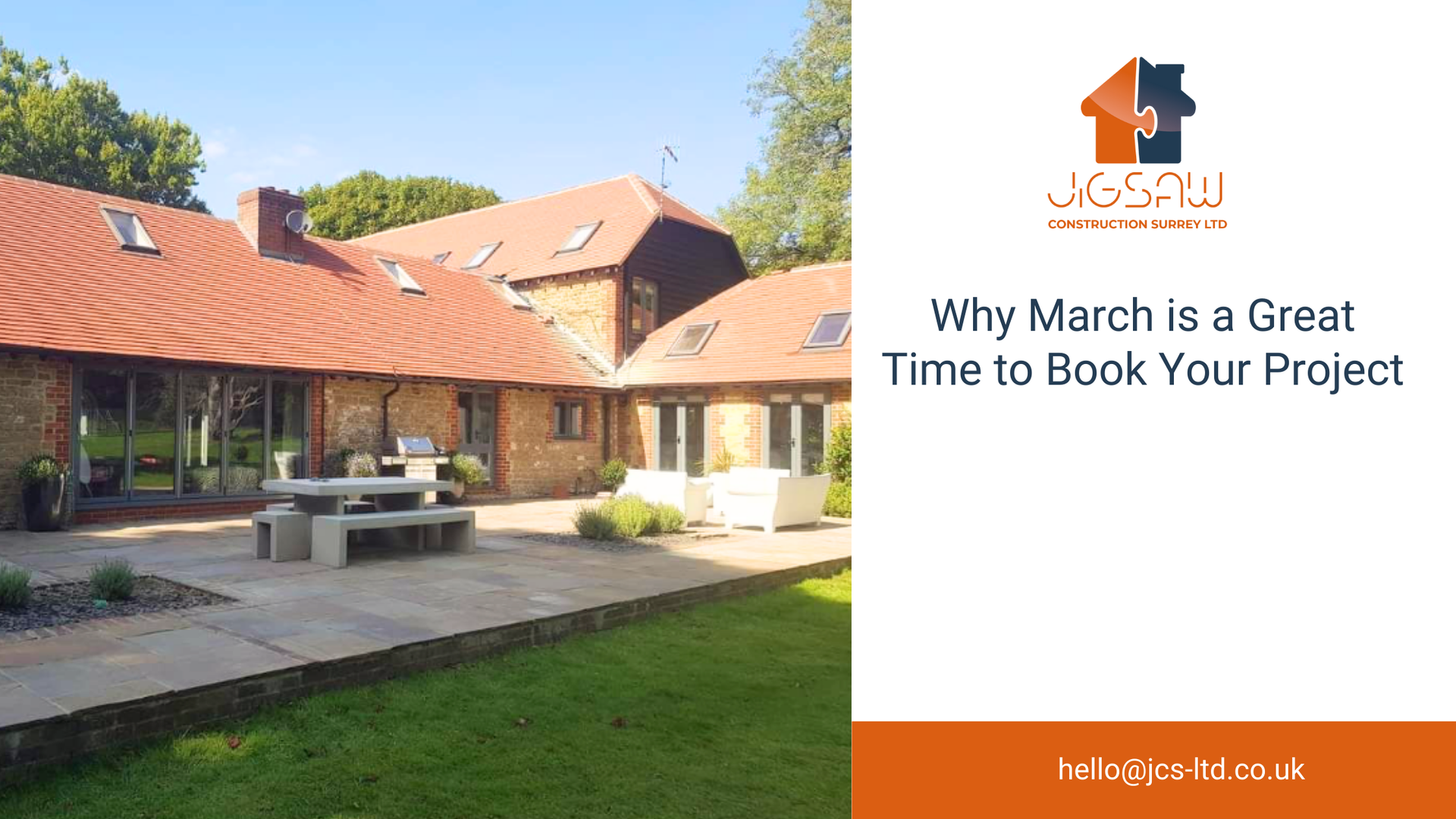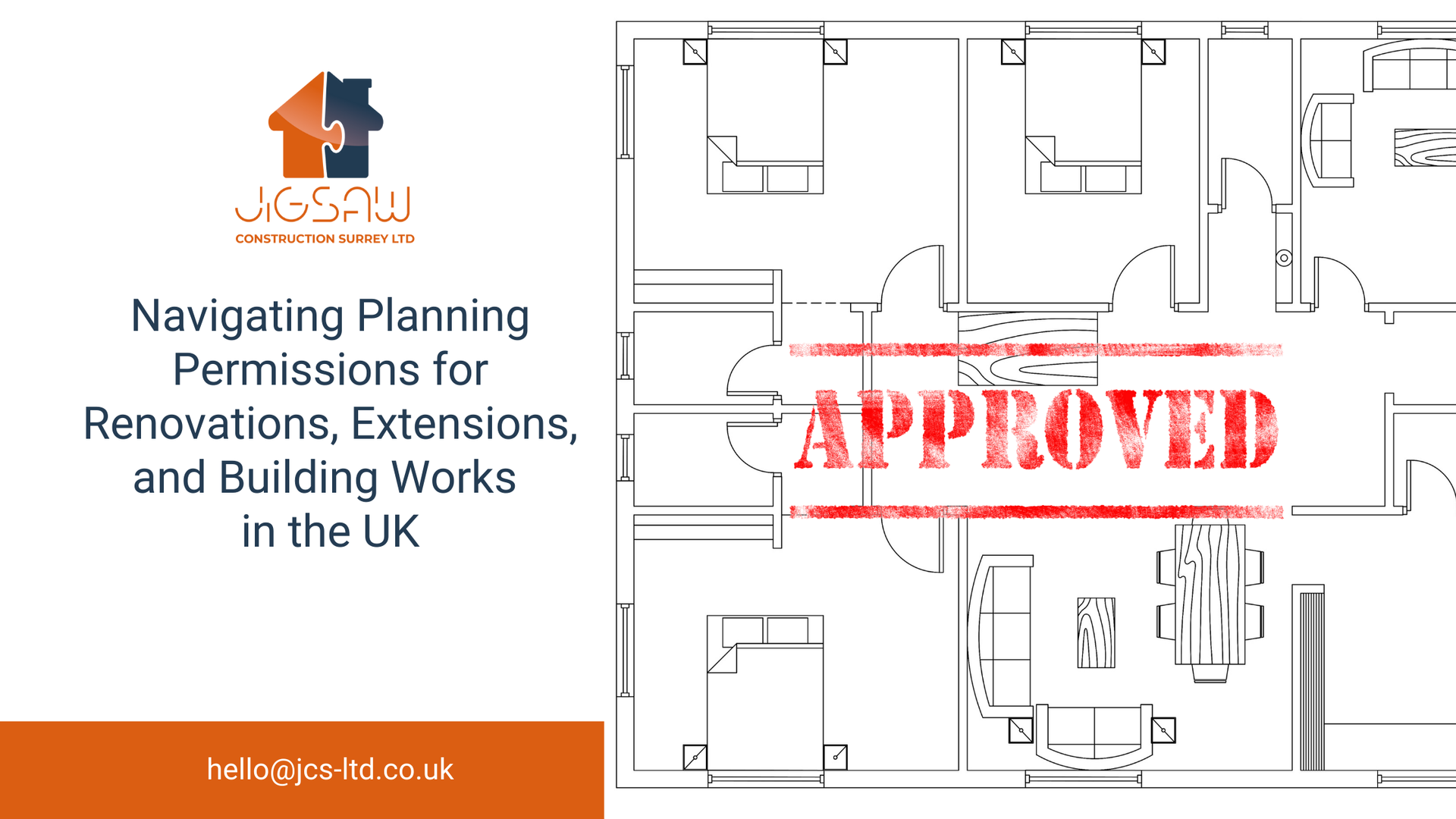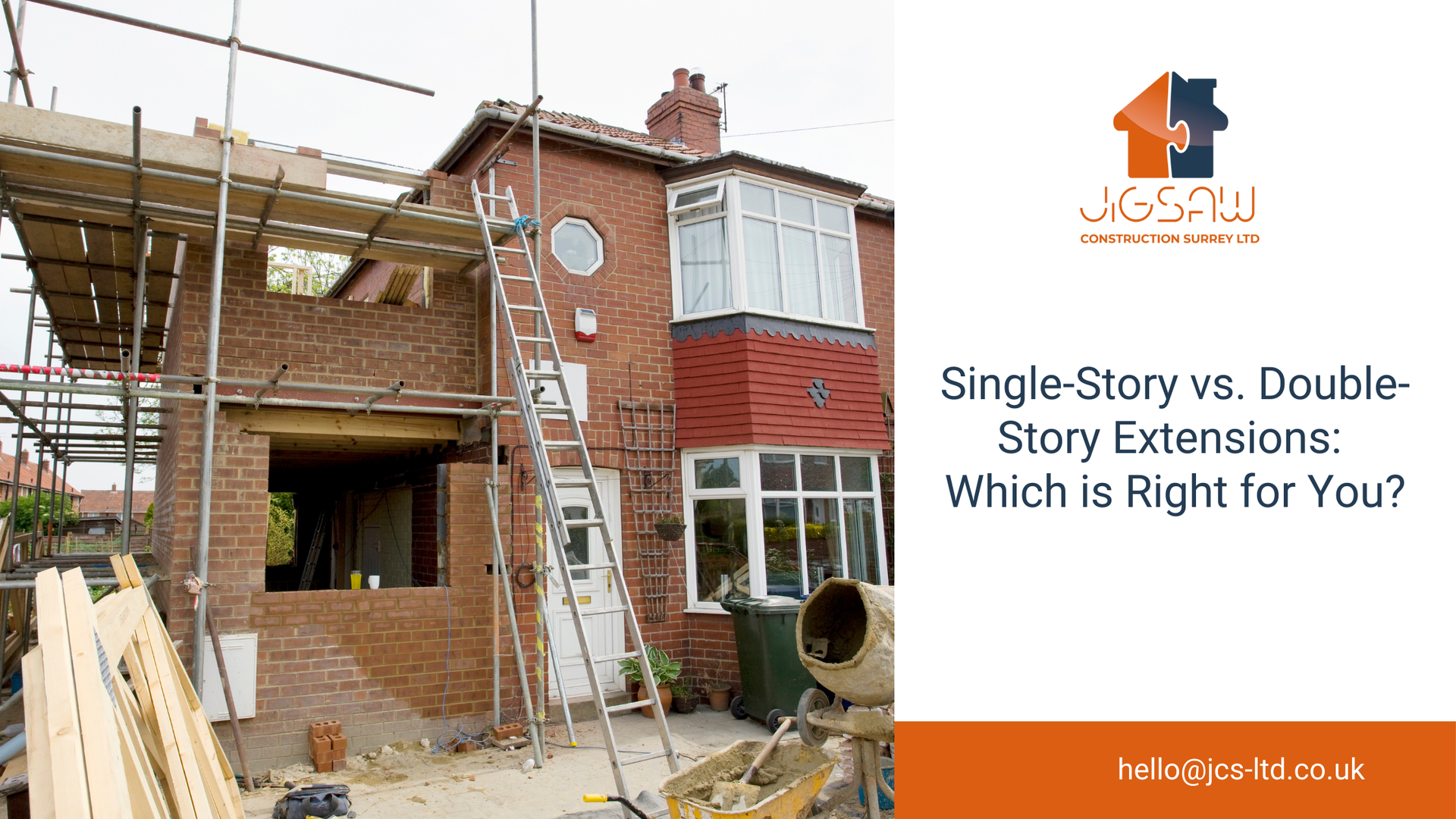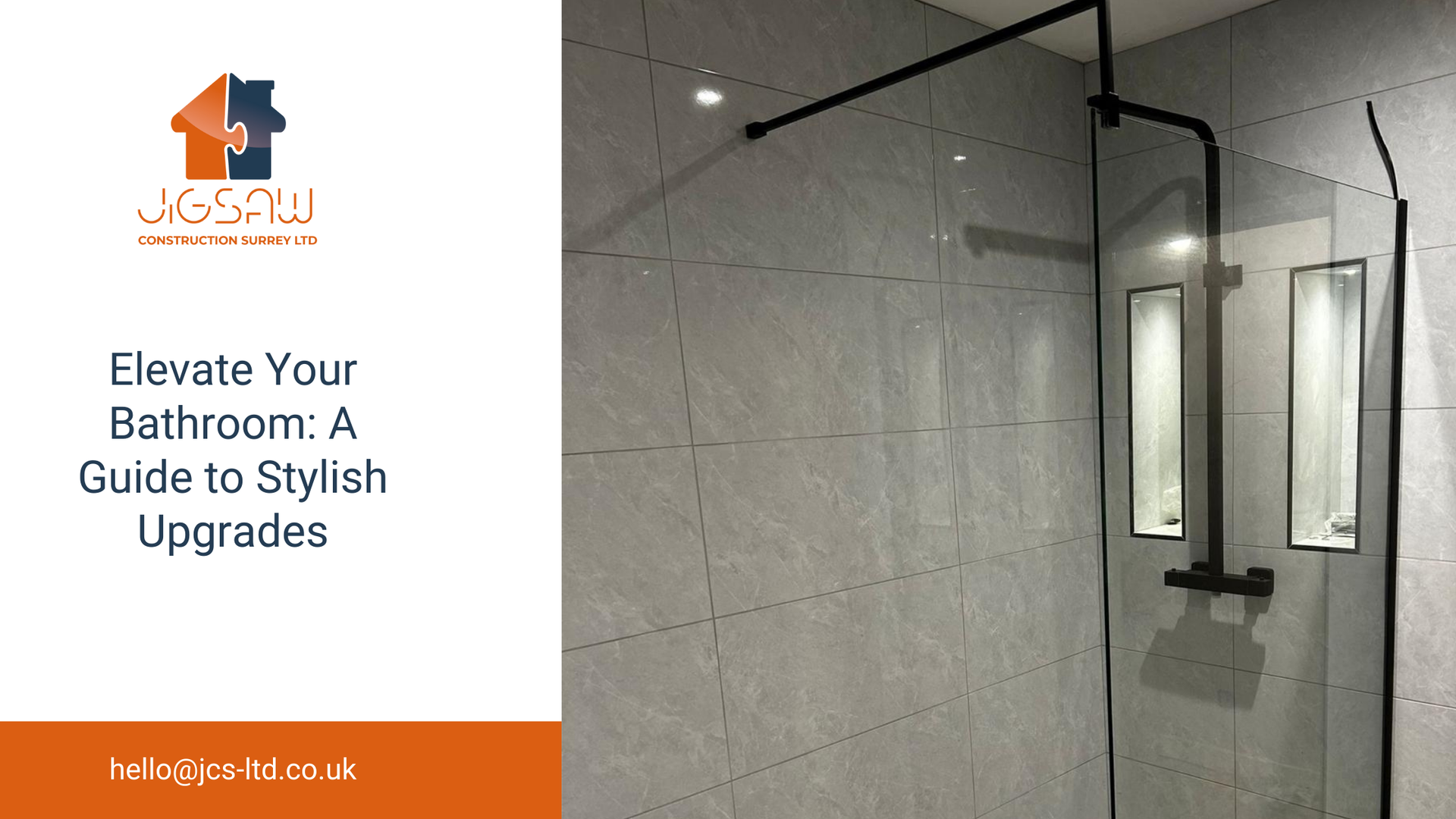
Connect with Jigsaw Construction
The INSPIRATION HUB

Thinking of Knocking Through? Here’s What You Need to Know! 🔨 Benefits of Knocking Through for a Kitchen-Diner: ✔ More space & a better flow ✔ A brighter, airier home with more natural light ✔ Perfect for entertaining – cook & chat with guests easily ✔ Adds value to your property ⚠ Things to Consider: 🔎 Is the wall load-bearing ? You may need structural support 💷 Budget for potential plumbing & electrical work 🏗 Be prepared for dust & disruption – but it’s worth it! A kitchen-diner knock-through can completely transform your home! Could it work for you? Read more in our blog: www.jcs-ltd.co.uk/blog #KnockThrough #HomeRenovation #KitchenDiner #OpenPlanLiving Why Choose JCS Ltd? At Jigsaw Construction Surrey Ltd , we bring expertise, quality craftsmanship, and a commitment to customer satisfaction . Our experienced team ensures your home improvement project is completed on time, within budget, and to the highest standards. With a proven track record in renovations, extensions, and bespoke building projects , we’re the trusted choice for homeowners looking to enhance their living spaces. We specialise in: Home extensions and renovations Kitchen and bathroom refurbishments Garden landscaping and patios Loft and garage conversions New build and custom projects Ready to Get Started? If you’re considering a home renovation or construction project this year, now is the perfect time to get in touch. Contact us today via www.jcs-ltd.co.uk to discuss your ideas and secure your spot with trusted local builders before our schedule fills up!

If you're thinking about a home renovation , house extension , or garden landscaping project this year, now is the time to act. March is the perfect month to start the planning process and get your project booked in before the summer rush. Here’s why: 1. Avoid Peak Season Delays As the weather warms up, more homeowners start planning their building projects . By securing your spot in March, you get ahead of the crowd and avoid long wait times. Builders’ schedules fill up fast , and delaying could mean pushing your project back by months. 2. Better Availability of Skilled Trades During peak season, high demand can make it harder to secure top-quality tradespeople . Booking in March gives you access to the best professionals before their calendars are fully booked. 3. Take Advantage of Mild Weather Spring brings better weather conditions for construction work compared to the unpredictability of winter or the intense heat of summer. Getting started in March allows for steady progress with fewer weather-related interruptions. 4. More Time for Planning and Permits If your project requires planning permission or building regulations approval , starting now ensures you have enough time for paperwork and approvals without causing delays. 5. Lock in Prices Before They Rise Building material costs fluctuate throughout the year, and demand-driven price increases are common in peak season. By booking in March, you can secure current pricing on home improvement projects and avoid potential cost hikes. 6. Enjoy Your New Space Sooner Whether it’s a new kitchen renovation , an outdoor patio , or a loft conversion , starting early means your project will likely be completed in time for summer, so you can enjoy your upgraded living space when it matters most. 7. Why Choose JCS Ltd? At Jigsaw Construction Surrey Ltd , we bring expertise, quality craftsmanship, and a commitment to customer satisfaction . Our experienced team ensures your home improvement project is completed on time, within budget, and to the highest standards. With a proven track record in renovations, extensions, and bespoke building projects , we’re the trusted choice for homeowners looking to enhance their living spaces. We specialise in: Home extensions and renovations Kitchen and bathroom refurbishments Garden landscaping and patios Loft and garage conversions New build and custom projects Ready to Get Started? If you’re considering a home renovation or construction project this year, now is the perfect time to get in touch. Contact us today via www.jcs-ltd.co.uk to discuss your ideas and secure your spot with trusted local builders before our schedule fills up!

When it comes to renovations, extensions, or any other significant building works, one of the most important things to consider is whether you need planning permission. In the UK, planning regulations are in place to ensure that development is safe, sustainable, and in keeping with the local environment. Whether you’re looking to extend your home, convert your loft, or build a new structure, it’s crucial to understand when planning permission is required and how to go about securing it. What is Planning Permission? Planning permission is the formal approval you need to carry out building works or change the use of land or buildings. It’s granted by the local council or planning authority in the area where your property is located. In general, planning permission is required for larger projects or works that could affect the surrounding area, but there are some exceptions, particularly with smaller, less invasive projects. When Do You Need Planning Permission? Certain types of works, particularly those that alter the structure or external appearance of a property, will typically require planning permission. Here are some common projects that may need approval: 1. Extensions and Loft Conversions Adding extra space to your home, whether through an extension or loft conversion, is a common reason for needing planning permission. There are specific rules on how far you can extend your property and how the extension should blend with the existing structure. 2. Conservatories While small conservatories may be covered by permitted development rights (which allow certain works without needing permission), larger conservatories, or those that extend into the boundaries of your property, will usually require full planning permission. 3. New Builds and Major Alterations Any new build or major structural changes to a property, including changing the layout or converting commercial properties into residential homes, typically require planning permission. 4. Changes to the External Appearance If you’re changing the appearance of the building by altering windows, doors, or the roofline, you may need permission. This is especially the case for listed buildings or properties in conservation areas. 5. Garden Structures Sheds, greenhouses, or other garden structures can also require permission if they exceed certain size limits or are placed in prominent locations. 6. Swimming Pools The construction of swimming pools or other large garden buildings may also require planning permission, especially if they affect the overall aesthetic or drainage of the property. What Are Permitted Development Rights? In many cases, small-scale works such as some types of extensions or conservatories can be carried out without the need for planning permission, under what’s called "permitted development." These rights allow homeowners to make certain changes to their property without applying for full planning permission, if they comply with specific restrictions. However, there are many conditions that govern permitted development, including: - Size limits for extensions or additions - Restrictions based on the location and position of your property (e.g., proximity to boundaries or listed status) - Limits on the height and depth of structures - Restrictions in areas such as conservation zones Before carrying out any work under permitted development, it’s essential to double-check whether your property qualifies and whether the work falls within the legal parameters. How to Apply for Planning Permission If your project requires planning permission, here’s a general guide to help you through the process: 1. Consult Your Local Planning Authority The first step is to contact your local planning authority (LPA). They will provide guidance on whether your proposal requires planning permission and what rules apply in your area. 2. Prepare Your Application You’ll need to provide detailed plans of the proposed works, including drawings and descriptions of the changes. You may also need to submit additional documents, such as site surveys, design and access statements, and environmental impact assessments. 3. Submit Your Application Applications can be submitted online through the Planning Portal or directly to your local authority. The cost of the application varies depending on the type and scale of your project. 4. Wait for a Decision Once your application is submitted, the local planning authority will assess it. This process usually takes about eight weeks for most applications. However, complex projects may take longer. If your application is approved, you’ll receive formal planning permission. If it’s refused, you have the right to appeal. 5. Building Regulations Approval Even if you get planning permission, you will likely need to submit your building works to building regulations approval, which ensures the construction meets health, safety, and energy efficiency standards. What Happens if You Don’t Get Planning Permission? Carrying out building works without the necessary planning permission can lead to fines, legal action, or even the requirement to undo the work. If you’re unsure about whether you need planning permission, it’s always better to ask before starting. There may also be penalties for failure to comply with other legal requirements, such as not following the right building regulations. Jigsaw Construction Surrey Ltd: Your Planning Partner Jigsaw Construction Surrey Ltd offers comprehensive project management services to streamline your building projects. From assessing whether planning permission is required to handling the application process, we ensure a hassle-free experience. With our expertise, you can confidently navigate complex regulations and focus on your vision, knowing that every step is professionally managed. We work closely with local authorities, ensuring all submissions meet the necessary standards and guidelines for a successful outcome. Get in touch to discuss your next construction project!

At Jigsaw Construction Surrey, we often get asked about the benefits of single or double story extensions. This blog talks about the pros and cons of each. When to Consider an Extension When your home starts feeling cramped or you want to add a bit of luxury with extra living space, adding an extension can be a fantastic solution. But one of the major decisions you’ll face is whether to opt for a single-story or double-story extension. Each comes with its unique advantages and drawbacks, and the right choice for you will depend on several key factors, from your budget to your future needs. Here are some of the pros and cons of each: Single-Story Extensions A single-story extension is an addition to your home that’s built on one level. These are usually connected to existing living spaces, such as extending the kitchen, dining room, or living room. Pros of Single-Story Extensions Single-story extensions typically require less structural work, making them a cost-effective solution for homeowners on a budget. Building a single-story extension often causes less upheaval, especially if the work doesn’t interfere with key areas like bedrooms and bathrooms. If your current foundations are in good shape, you might be able to avoid major (and costly) construction work, further reducing costs and build time. Single-story extensions allow you to create a spacious, open-plan layout that can make your home feel more modern and comfortable. Cons of Single-Story Extensions While single-story extensions can add plenty of useful space, they’re limited in terms of how much room they can provide compared to a double-story option. Depending on where you live, getting approval for a single-story extension may be tricky, particularly in areas with strict building regulations. Here are some examples of rooms that are commonly built as single-story extensions: Kitchen: Expanding your kitchen is a popular choice for many homeowners, as it's a central hub of the home. Living room: Adding a living room extension can create a spacious and comfortable area for relaxing and entertaining. Bedroom: If you need additional bedrooms, a single-story extension can be a great option. Home office: Creating a dedicated home office space can be a valuable addition to your home. Playroom: If you have children, a playroom extension can provide a designated space for them to play and learn. Conservatory: A conservatory can add a bright and airy space to your home, perfect for relaxing or entertaining. Double-Story Extensions If you’re looking to significantly expand your home’s footprint, a double-story extension might be the answer. These extensions add space on two levels, allowing you to create more bedrooms, bathrooms, or living spaces Pros of Double-Story Extensions The most obvious advantage of a double-story extension is the extra room you’ll get. Whether you need additional bedrooms, a larger kitchen, or more space for entertaining, a double-story extension can offer significant square footage. As your family grows, you might find that you need more space for bedrooms, bathrooms, or play areas. A double-story extension can help meet these needs without the need to move to a new home. Investing in a double-story extension can add substantial value to your home, which is particularly appealing if you’re planning to sell in the future. Cons of Double-Story Extensions Double-story extensions require more materials, labour, and planning, which makes them a more expensive option compared to single-story builds. The longer construction time can also cause more disruption to your daily routine. Building a second floor on your home can be highly disruptive, especially if work involves key living areas such as bedrooms and bathrooms. It may require you to temporarily relocate during some stages of the build. To support a second story, your home’s foundation may need reinforcement, which adds to both the time and cost of the project. Here are some common types of rooms that can be built as a double-story extension: Bedrooms: Adding extra bedrooms is a popular reason for building a double-story extension. En-suite bathrooms: Having a private bathroom attached to a bedroom can be a luxurious addition. Dressing rooms: If you have a lot of clothes, a dressing room can be a great way to keep your wardrobe organized and clutter-free. Home offices: A dedicated home office can provide a quiet and productive workspace. Playrooms: If you have children, a playroom can be a great addition to your home. Kitchens: Expanding your kitchen can create a more open and functional space. Living rooms: Adding a second living room can provide a separate space for entertaining or relaxing. Factors to Consider Before you decide whether a single-story or double-story extension is best for you, it’s essential to consider a few important factors: Budget: Single-story extensions are generally less expensive than double-story extensions. If you have a limited budget, a single-story extension might be the best option. Planning Permission: It’s important to consult your local planning authority to understand what types of extensions are permitted in your area. In some cases, you may face more restrictions for double-story builds. Lifestyle: Think about your family’s current and future needs. Do you need more bedrooms for a growing family? Or are you looking to create a more open, spacious layout? Your lifestyle will play a big role in determining which type of extension is right for you. Property Value: If you’re thinking about resale value, it’s worth noting that double-story extensions typically add more value to your property than single-story builds. The type of room you choose will depend on your specific needs and lifestyle. It's important to consider your family's size, hobbies, and how you want to use the additional space. To discuss your extension, get in touch

Transform your bathroom into a spa-like oasis with these stylish and functional upgrades. 1. Expand Your Space: Add an enclosed shower: Enjoy privacy and luxury with a separate shower enclosure. Install a walk-in shower : Create a modern and accessible space. Create a second bathroom: Increase convenience and value for your home. 2. Modernise Your Bathroom: Replace outdated fixtures: Upgrade your sink, toilet, and bathtub for a fresh look. Update tiles and flooring: Choose stylish and durable materials like porcelain or ceramic tiles. Install a heated floor: Enjoy the luxury of warm floors year-round. 3. Design Tips: Maximise natural light: Install larger windows or a skylight for a brighter space. Choose calming colours: Opt for colours that create a relaxing atmosphere. Add storage: Incorporate cabinets, shelves, and drawers for organisation. Create a focal point: A statement piece can add personality to your bathroom. 4. Monochrome Magic: Embrace charcoal : Add depth and sophistication to a white bathroom with soft charcoal shades. Experiment with tiles and grout: Create a unique monochrome look with different shades and patterns. Add a pop of colour: Introduce a bold colour accent for a focal point. 5. Natural Textures and Period Style: Incorporate rustic elements: Use textured walls, natural flooring, and exposed brick for a cosy feel. Add period-inspired details: Install dramatic lighting, brass fixtures, flowing curtains, and period rugs for a touch of luxury. 6. Product Advice: Choose water-saving fixtures: Opt for low-flow faucets and toilets. Install energy-efficient lighting: LED lighting creates a warm ambiance and saves energy. Select a functional and stylish vanity: Consider storage options and design. Add mirrors with built-in lighting : Enhance your bathroom's functionality and aesthetics. By incorporating these upgrades, you can create a luxurious and functional bathroom that reflects your personal style and enhances your daily routine. Here are some reasons why you might consider extending your bathroom: Lack of space: If your current bathroom is cramped and doesn't meet your needs, an extension can provide more room for activities like bathing, getting ready, and relaxing. Increased functionality: An extension can allow you to add features like a separate shower, a double sink, or additional storage space. Enhanced value: A well-designed bathroom extension can significantly increase the value of your home. Improved aesthetics: You can create a more stylish and modern bathroom that reflects your personal taste. Better accessibility: If you have mobility issues, an extension can help create a more accessible bathroom. Ultimately, the decision to extend your bathroom depends on your individual needs and preferences. Consider your budget, lifestyle, and the potential benefits before making a decision. Here are some popular bathroom features for 2024: Walk-in showers: These spacious and accessible showers are becoming increasingly popular. Freestanding bathtubs: Freestanding tubs add a touch of luxury and elegance to a bathroom. Smart toilets: These high-tech toilets offer features like heated seats, automatic flushing, and air purification. Double sinks: Double sinks are a practical and stylish choice for bathrooms shared by multiple people. Natural materials: Incorporating natural materials like stone, wood, and plants can create a calming and spa-like atmosphere. Minimalist design: Clean lines, neutral colours, and uncluttered spaces are popular trends in bathroom design. Smart technology: Smart mirrors, voice-activated faucets, and heated towel racks are adding a touch of luxury and convenience to bathrooms. Sustainable features: Eco-friendly materials, low-flow fixtures, and energy-efficient lighting are becoming more popular as homeowners seek sustainable options. Would you like to know more about any of these features or discuss other bathroom design ideas? Contact Jigsaw Construction Ltd to discuss your bathroom upgrade requirements and enjoy quality service with superior finishes. We can manage your project from start to finish so you can relax and enjoy the finished result. https://www.jcs-ltd.co.uk/#ContactUs

Britain's unpredictable weather, from torrential downpours to autumnal leaf fall, puts significant strain on our homes. One often-overlooked component is the humble gutter. When working optimally, your gutters silently protect your property from water damage. However, neglect can lead to costly issues. Let’s explore why gutter cleaning is essential and how it intertwines with the health of your facia and soffit. Gutter Woes: A Common British Problem From the rolling hills of the countryside to the urban sprawl, British homes are susceptible to gutter blockages. Leaves, twigs, moss, and even birds' nests can accumulate, hindering the smooth flow of rainwater. This can result in: Damp and mould: Water ingress through blocked gutters can lead to damp patches, mould growth, and musty smells. Structural damage: Persistent water build-up can erode foundations, damage brickwork, and cause problems with woodwork. Roof issues: Ice dams created by blocked gutters can form in winter and cause pooling water which could leak and damage roof tiles, perimeter walls and grounds. The Facia and Soffit Connection Your facia and soffit form the crucial framework beneath your roofline. They work in tandem with your gutters to shield your home from the elements. When neglected, they can: Accelerate gutter problems: Rotting facia boards can cause gutters to sag or detach. Compromise roof ventilation: Blocked soffit vents disrupt airflow, leading to damp and condensation issues. Affect aesthetics: Deteriorated facia and soffit can drastically impact your home's appearance. The Benefits of Gutter Cleaning and New Facia/Soffit Investing in gutter maintenance and potentially replacing your facia and soffit offers numerous advantages: Protect your home: Safeguard your property from costly water damage and structural issues. Enhance your home's appearance: New facia and soffit can give your home a fresh look. Increase property value: Well-maintained exteriors can boost your home's market value. Peace of mind: Knowing your home is protected from the elements provides reassurance. Gutter Cleaning: A Seasonal Task Britain's seasonal changes make gutter cleaning essential. Autumn leaf fall is a prime time for clearing, but spring checks are also advisable to remove winter debris. For areas with mature trees or heavy rainfall, more frequent cleaning might be necessary. Safety First: Gutter cleaning can be hazardous, especially for taller properties. How Jigsaw Construction Surrey Can Help with Gutter Clearing and Facia/Soffit Replacement Gutter Clearing Professional equipment: We have the necessary ladders, tools, and equipment to safely and efficiently clear your gutters. Expert knowledge: We understand the importance of proper gutter maintenance and can identify potential problems. Additional services: We offer additional services like gutter guards or repairs to prevent future blockages. Facia and Soffit Replacement Comprehensive service: We assess the condition of your facia and soffit, provide quotes, and complete the replacement. Material expertise: We have knowledge of different materials and can recommend suitable options for your home. Coordination with other work: If you need additional exterior work done, such as roofing or window repairs, we can coordinate all aspects of the project. Additional Benefits Peace of mind: At Jigsaw Construction Surrey, we always ensure the job is done right, reducing the risk of further damage. Timesaving: We complete the work efficiently, saving you time and effort. Warranty: We offer warranties on our work, providing added protection. By choosing Jigsaw Construction Ltd, you can ensure that your gutter cleaning and facia/soffit replacement are handled professionally and effectively. Visit https://www.jcs-ltd.co.uk/#ContactUs and get in touch!

Ah, July! The sun is shining, the days are long, and it's the perfect time to give your home's exterior a refresh. Here at Jigsaw Construction, Surrey, we see a surge in painting projects this month, and for good reason. Fresh paint on your render (exterior wall surface) and woodwork can completely transform your home's curb appeal, making it the envy of the block. But before you grab a brush and dive in, here are some key things to consider for painting your render and woodwork in July: The July Sun- A Blessing and a Curse July's sunshine provides ideal drying conditions for paint, but it can also work against you. Here's how to manage the heat: Pick Your Time Wisely: Avoid painting in the hottest part of the day. Early mornings or evenings offer cooler temperatures that allow the paint to dry evenly and prevent it from baking on too quickly. Work in Sections: Don't try to tackle the entire house at once. Break down the project into smaller sections and paint them in stages to avoid large areas of exposed render in direct sunlight. Keep it Hydrated: This applies to both you and the paint! Stay hydrated with water while you work and consider using a damp cloth to occasionally wipe down the painted area to prevent the paint from drying too quickly. Choosing the Right Paint for Render and Woodwork: Render Choose a breathable masonry paint specifically designed for exterior use on rendered surfaces. These paints allow moisture vapor to escape from the wall, preventing problems like blistering and peeling. Woodwork Choose a high-quality exterior wood paint that can withstand the elements. Consider a paint with a built-in primer for added protection, especially on weathered wood. Preparing for Perfection A good paint job is all about proper preparation. Here's what you need to do: Thoroughly clean both the render and woodwork to remove dirt, dust, cobwebs, and any loose paint. A power washer can be a helpful tool for render, but always use a low-pressure setting to avoid damaging the surface. Fill any cracks or holes in the render with a suitable exterior filler. Sand down any rough surfaces on both the render and woodwork to ensure a smooth finish for the paint. Use masking tape to protect areas you don't want painted, like windows, doors, and gutters. The Finishing Touches Once the painting is complete, remove all masking tape carefully. Inspect your handiwork and touch up any minor imperfections. Finally, sit back and admire the refreshed look of your home! In July, it's especially important to be mindful of the potential for wasps and bees. Choose a location away from your work area to store your paint and equipment to avoid attracting these summertime pests. Why Use Professionals? While exterior painting might seem like a DIY project, there are several advantages to hiring a professional company like Jigsaw Construction Surrey. Quality and Expertise We have the experience and knowledge to properly prepare surfaces, choose the right paint for your climate and materials, and apply it with a flawless finish. This leads to a longer-lasting, better-looking paint job. Safety Exterior painting often involves working at heights and around electrical hazards. Professionals are trained and insured to handle these risks safely. Efficiency and Timesaving Painting your house exterior is a time-consuming job. Professionals can get the job done quickly and efficiently, minimising disruption to your routine. Cleanliness Pros know how to properly protect your property from paint splatters and drips. They'll also clean up thoroughly after the job is finished. Warranty and Guarantee At Jigsaw Construction Surrey, we offer warranties on our work giving you peace of mind that we will fix any problems that arise. Ready to give your home a July makeover? Contact Jigsaw Construction today for a free quote on your painting project!



